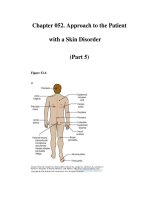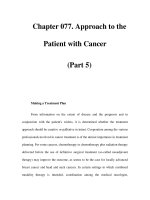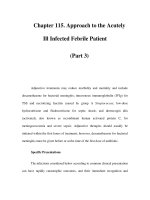general approach to the trauma patient

Chapter 052. Approach to the Patient with a Skin Disorder (Part 1) ppt
... assume that the erosion is the primary lesion and the redness and scale are secondary, while the correct interpretation would be that the patient has a pruritic eczematous dermatitis with erosions ... (Table 52-4) For instance, the finding of scaling papules (present in patients with psoriasis or atopic dermatitis) places the patient in a different diagnostic category than would hemorrhagic papules, ... important to differentiate primary from secondary skin lesions If the examiner focuses on linear erosions overlying an area of erythema and scaling, he or she may incorrectly assume that the erosion...
Ngày tải lên: 06/07/2014, 20:20

Chapter 052. Approach to the Patient with a Skin Disorder (Part 2) potx
... epidermal atrophy) Scar: A change in the skin secondary to trauma or inflammation Sites may be erythematous, hypopigmented, or hyperpigmented depending on their age or character Sites on hair-bearing ... incomplete rings Pruritus: A sensation that elicits the desire to scratch Pruritus is often the predominant symptom of inflammatory skin diseases (e.g., atopic dermatitis, allergic contact dermatitis); ... Lichenoid: Violaceous to purple, polygonal lesions that resemble those seen in lichen planus Milia: Small, firm, white papules filled with keratin Morbilliform: Generalized, small erythematous macules...
Ngày tải lên: 06/07/2014, 20:20

Chapter 052. Approach to the Patient with a Skin Disorder (Part 4) doc
... hospitalized patient with a generalized erythematous exanthem is more likely to have a drug eruption than is a patient with a similar rash limited to the sun-exposed portions of the face Once the distribution ... possible to assess the distribution of the eruption accurately The patient should first be viewed from a distance of about 1.5–2 m (4–6 ft) so that the general character of the skin and the distribution ... SKIN DISORDER In examining the skin it is usually advisable to assess the patient before taking an extensive history This way, the entire cutaneous surface is sure to be evaluated, and objective...
Ngày tải lên: 06/07/2014, 20:20

Chapter 052. Approach to the Patient with a Skin Disorder (Part 5) pptx
... A–D The distribution of some common dermatologic diseases and lesions Figure 52-7 Psoriasis This papulosquamous skin disease is characterized by small and large erythematous papules...
Ngày tải lên: 06/07/2014, 20:20

Chapter 052. Approach to the Patient with a Skin Disorder (Part 6) pdf
... contrast, lesions with a generalized arrangement are common and suggest a systemic etiology Figure 52-9 Erythema multiforme This eruption is characterized by multiple erythematous plaques with a target ... morphology It usually represents a hypersensitivity reaction to drugs (e.g., sulfonylamides) or infections (e.g., HSV) (Courtesy of the Yale Resident's Slide Collection; with permission.) Figure...
Ngày tải lên: 06/07/2014, 20:20

Chapter 052. Approach to the Patient with a Skin Disorder (Part 7) ppt
... pressed against the surface of the skin and rotated with downward pressure until it penetrates to the subcutaneous tissue The circular biopsy is then lifted with forceps, and the bottom is cut with ... History of allergies Presence of photosensitivity Review of systems Family history (particularly relevant for patients with melanoma, atopy, psoriasis, or acne) 10 Social, sexual, or travel history ... of the slide accelerates dissolution of keratin When the preparation is viewed under the microscope, the refractile hyphae will be seen more easily when the light intensity is reduced and the...
Ngày tải lên: 06/07/2014, 20:20

Chapter 052. Approach to the Patient with a Skin Disorder (Part 8) pptx
... is designed to document sensitivity to a specific antigen In this procedure, a battery of suspected allergens is applied to the patient' s back under occlusive dressings and allowed to remain in ... helpful in the evaluation of patients with chronic dermatitis FURTHER READINGS Dermatology Lexicon Project: www.futurehealth.rochester.edu/dlp2/ James WD et al: Andrews' Diseases of the Skin: ... allowed to remain in contact with the skin for 48 h The dressings are removed, and the area is examined for evidence of delayed hypersensitivity reactions (e.g., erythema, edema, or papulovesicles)...
Ngày tải lên: 06/07/2014, 20:20

Chapter 077. Approach to the Patient with Cancer (Part 1) potx
... diseases occur because the specialized cells fail to perform their assigned task Cancer takes this malfunction one step further Not only is there a failure of the cancer cell to maintain its specialized ... same as the prognosis of the person with aortic stenosis who develops the first symptoms of congestive heart failure (median survival, ~8 months) However, the patient with heart disease ... of cancer cells is that the patient feels betrayed by his or her body The cancer patient feels that he or she, and not just a body part, is diseased The Magnitude of the Problem No nationwide...
Ngày tải lên: 07/07/2014, 01:20

Chapter 077. Approach to the Patient with Cancer (Part 3) pptx
... The past medical history may alert the physician to the presence of underlying diseases that may affect the choice of therapy or the side effects of treatment The social history may reveal occupational ... predisposition and point out the need to begin surveillance or other preventive therapy for unaffected siblings of the patient The review of systems may suggest early symptoms of metastatic disease ... procedure, the diagnosis generally depends on obtaining adequate tissue to permit careful evaluation of the histology of the tumor, its grade, and its invasiveness and to yield further molecular...
Ngày tải lên: 07/07/2014, 01:20

Chapter 077. Approach to the Patient with Cancer (Part 4) pps
... Against Cancer and the American Joint Committee on Cancer (AJCC) The TNM classification is an anatomically based system that categorizes the tumor on the basis of the size of the primary tumor ... other prognostic factors have been identified (Chaps 104, 105, and 106) In addition to tumor burden, a second major determinant of treatment outcome is the physiologic reserve of the patient Patients ... of the organ of origin to regional but not distant sites, or as metastatic to distant sites The most widely used system of staging is the TNM (tumor, node, metastasis) system codified by the...
Ngày tải lên: 07/07/2014, 01:20

Chapter 077. Approach to the Patient with Cancer (Part 5) doc
... physician also has much to offer the patient for whom curative therapy is no longer an option Often a combination of guilt and frustration over the inability to cure the patient and the pressure of a ... 81) Tools are now available to minimize the acute toxicity of cancer treatment New symptoms developing in the course of cancer treatment should always be assumed to be reversible until proven otherwise ... modifications of standard protocols are likely to compromise treatment results The choice of treatment approaches was formerly dominated by the local culture in both the university and the practice settings...
Ngày tải lên: 07/07/2014, 01:20

Chapter 077. Approach to the Patient with Cancer (Part 6) pdf
... Pregnancy disease, gonadal germ cell tumor Calcitonin Medullary cancer of the thyroid Catecholamines Pheochromocytoma Oncofetal Antigens Alphafetoprotein Hepatocellular carcinoma, gonadal germ Cirrhosis, ... Neuron-specific enolase Lactate dehydrogenase Small cell cancer of the lung,neuroblastoma Lymphoma, Ewing's sarcoma Hepatitis, hemolytic many others Tumor-Associated Proteins anemia, Prostate-specific ... Carcinoembryonic antigen Adenocarcinomas hepatitis Pancreatitis, of the colon, pancreas, hepatitis, lung, breast, ovary inflammatory bowel disease, smoking Enzymes Prostatic acid Prostate cancer...
Ngày tải lên: 07/07/2014, 01:20

Chapter 077. Approach to the Patient with Cancer (Part 7) ppt
... cured of cancer return to normal lives Supportive Care In many ways, the success of cancer therapy depends on the success of the supportive care Failure to control the symptoms of cancer and its ... nonjudgmental, so that patients are more likely to discuss with the physician what they are actually doing The appearance of unexpected toxicity may be an indication that a supplemental therapy is being ... in the course of their disease Unsound approaches are usually hawked on the basis of unsubstantiated anecdotes and not only cannot help the patient but may be harmful Physicians should strive to...
Ngày tải lên: 07/07/2014, 01:20

Chapter 077. Approach to the Patient with Cancer (Part 8) potx
... signals in the chemoreceptor trigger zone in the medulla, the cerebral cortex, and peripherally in the intestinal tract lead to stimulation of the vomiting center in the medulla, the motor center ... on which to indicate the severity of the pain The clinical condition is often dynamic, making it necessary to reassess the patient frequently Pain therapy should not be withheld while the cause ... caused by chemotherapy (Chap 81) Its severity can be predicted from the drugs used to treat the cancer Three forms of emesis are recognized on the basis of their timing with regard to the noxious...
Ngày tải lên: 07/07/2014, 01:20

Chapter 077. Approach to the Patient with Cancer (Part 11) pot
... may provide more tools in the future as cytokine-mediated mechanisms are further elucidated Psychosocial Support The psychosocial needs of patients vary with their situation Patients undergoing ... another 24 h The tube is then disconnected from suction and allowed to drain by gravity If
Ngày tải lên: 07/07/2014, 01:20

Chapter 077. Approach to the Patient with Cancer (Part 12) pot
... difficult for the physician as well as for the patient and family The critical features of the interaction are to reassure the patient and family that everything that can be done to provide comfort ... hope Of course, patients not all progress through all the stages or proceed through them in the same order or at the same rate Nevertheless, developing an understanding of how the patient has been ... affected by the diagnosis and is coping with it is an important goal of patient management It is best to speak frankly with the patient and the family regarding the likely course of disease These discussions...
Ngày tải lên: 07/07/2014, 01:20

Chapter 115. Approach to the Acutely Ill Infected Febrile Patient (Part 1) docx
... Approach to the Patient: Acute Febrile Illness A physician must have a consistent approach to acutely ill patients Even before the history is elicited and a physical ... Assessment of the patient' s general appearance and vital signs, skin and soft tissue examination, and the neurologic evaluation are of particular importance The patient may appear either anxious ... infection, diabetes, malignancy, and chemotherapy all predispose to specific infections and frequently to increased severity The patient should be questioned about factors that might help identify a nidus...
Ngày tải lên: 07/07/2014, 04:20

Chapter 115. Approach to the Acutely Ill Infected Febrile Patient (Part 2) pptx
... (U.S.), Either: Atovaqu one and 01, 204 with fewer side or effects Treatmen Atovaquone t (750 mg q12h) plus with doxycycline c Azithromycin (100 mg bid ) (500-mg loading for potential dose, then 250 ... particularly in the setting of relative adrenal insufficiency c Tetracyclines can be antagonistic in action to β-lactam agents Adjust treatment as soon as the diagnosis is confirmed d The optimal ... discontinued Erythroder Group A Vancomycin If ma: toxic shock Streptococcus, (1 g q12h) plus penicillin- syndrome oxacillin- Staphylococcus a or 29, 130 toxigenic bacteria should be debrided; IV immunoglobuli...
Ngày tải lên: 07/07/2014, 04:20

Chapter 115. Approach to the Acutely Ill Infected Febrile Patient (Part 3) pps
... patients succumb to sepsis at 58 times the rate of the general population; 50–70% of cases occur within the first years after splenectomy, with a mortality rate of up to 80%, but the increased risk ... encapsulated bacteria cause the majority of infections Adults, who are more likely to have antibody to these organisms, are at lower risk than children Streptococcus pneumoniae is the most common isolate, ... streptococci can present as intractable hypotension and multiorgan failure Treatment can usually be initiated empirically on the basis of the presentation (Table 265-3) Adjunctive therapy with either...
Ngày tải lên: 07/07/2014, 04:20

Chapter 115. Approach to the Acutely Ill Infected Febrile Patient (Part 4) potx
... of patients have skin findings Blanching macules develop initially on the wrists and ankles and then spread over the legs and trunk The lesions become hemorrhagic and are frequently petechial The ... petechial The rash spreads to palms and soles later in the course The centripetal spread is a classic feature of RMSF However, 10–15% of patients with RMSF never develop a rash The patient can be hypotensive ... Asia, and southern Europe Patients have fever, flu-like symptoms, and an inoculation eschar at the site of the tick bite A maculopapular rash develops within 1–7 days, involving the palms and...
Ngày tải lên: 07/07/2014, 04:20